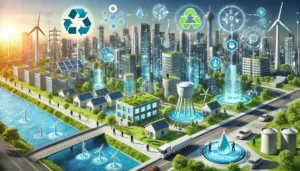An Environmental Engineer is a professional who applies principles of engineering, soil science, biology, and chemistry to solve environmental problems. They design systems for waste disposal, improve water and air quality, and develop sustainable solutions to protect human health and ecosystems.
These engineers play an important role in addressing climate change, pollution, and resource conservation. They work in industries like government agencies, consulting firms, and private companies to ensure environmental regulations are met.
Role and Importance of Environmental Engineers in Society

Steps to Become an Environmental Engineer.
Step 1: Get the Right Education.
Earn a Bachelor’s Degree.
To become an Environmental Engineer, you need a bachelor’s degree in Environmental Engineering or a related field like Civil or Chemical Engineering. This degree usually takes four years to complete. During your studies, you will learn about math, chemistry, physics, and environmental regulations. These subjects help you understand how to solve environmental problems using science and engineering.
Consider a Master’s Degree (Optional).
A master’s degree is not required, but it can help you get better job opportunities. It allows you to specialize in areas like water treatment, air pollution control, or renewable energy. A master’s degree takes one to two years to complete.
Step 2: Gain Practical Experience.
Complete an Internship.
Internships are a great way to get hands-on experience while studying. They help you apply what you learn in real-world situations. Many companies and government agencies offer internships for students. Internships help you understand how Environmental Engineers work. You will learn how to test air and water quality, analyze data, and help design environmental projects.
Start an Entry-Level Job.
After graduation, you can work as a Junior Environmental Engineer or Engineering Technician. In these roles, you will assist senior engineers with data collection, pollution control projects, and environmental impact assessments.
Step 3: Get Licensed and Certified.
Pass the Fundamentals of Engineering (FE) Exam.
The FE Exam is the first step to becoming a licensed Environmental Engineer. It tests your understanding of engineering principles. Most students take this exam after completing their degree.
Gain Work Experience.
After passing the FE exam, you must work for four years under a licensed engineer. This experience is required before you can take the final licensing exam.
Pass the Professional Engineer (PE) Exam.
The PE Exam allows you to become a fully licensed Environmental Engineer. Once you pass, you can work independently and take on more responsibilities.
Earn Additional Certifications.
Getting extra certifications can help you stand out in the job market. Some popular ones include:
- LEED Certification (for green building and sustainability).
- Certified Environmental Engineer (CEE) (for advanced environmental expertise).
- OSHA Certification (for safety regulations).
Step 4: Develop Important Skills.
To succeed as an Environmental Engineer, you need both technical skills and soft skills.
Technical skills include knowledge of pollution control, water treatment, environmental laws, and data analysis.
Soft skills like problem-solving, communication, and teamwork help you work effectively with other professionals.
Step 5: Explore Career Opportunities.
Where Environmental Engineers Work.
Environmental Engineers work in government agencies, private companies, and non-profit organizations. They help industries follow environmental laws and develop eco-friendly solutions. Common employers include:
- Government agencies (like the Environmental Protection Agency).
- Engineering consulting firms.
- Manufacturing companies.
- Renewable energy companies.
Common Job Titles.
As an Environmental Engineer, you can work in different roles. Some common job titles include:
- Environmental Engineer.
- Sustainability Engineer.
- Water Resource Engineer.
- Air Quality Engineer.
- Environmental Consultant.
RELATED BLOG: Biomedical Engineering: A High-Paying Career in Healthcare and Technology
Role and Importance of Environmental Engineers in Society.
Environmental Engineers play a critical role in making the world a cleaner, safer, and healthier place. Their work helps reduce pollution, conserve natural resources, and improve public health. They use science and engineering to solve environmental problems and make industries more sustainable.
1. Protecting Air and Water Quality.
One of the most important jobs of an Environmental Engineer is to ensure that the air we breathe and the water we drink are clean and safe.
- They design air filtration systems to reduce harmful gases released by factories.
- They create wastewater treatment plants to clean polluted water before it enters rivers and lakes.
- They conduct air and water quality tests to check for dangerous levels of pollution.
Without Environmental Engineers, pollution levels would rise, leading to health problems like respiratory diseases, contaminated drinking water, and loss of aquatic life.
2. Managing Waste and Recycling.
Environmental Engineers develop waste management systems that help reduce, recycle, and safely dispose of waste.
- They design landfills that prevent toxic chemicals from leaking into the soil.
- They create recycling programs that help reuse materials like plastic, metal, and glass.
- They find ways to convert waste into energy, such as producing electricity from landfill gases.
Proper waste management prevents land, water, and air pollution, making the environment safer for both people and wildlife.
3. Climate Change.
Climate change is one of the biggest challenges in the world today. Environmental Engineers help reduce greenhouse gas emissions and promote sustainable solutions.
- They design renewable energy systems like solar, wind, and hydroelectric power.
- They develop carbon capture technologies to remove harmful gases from the atmosphere.
- They improve the efficiency of industrial processes to reduce energy waste and emissions.
By working on these solutions, they help slow down global warming and protect future generations.
4. Ensuring Industries Follow Environmental Laws.
Many industries produce pollution and hazardous waste. Governments have created environmental laws to protect people and nature. Environmental Engineers help companies follow these laws and reduce their environmental impact.
- They inspect factories, construction sites, and power plants to check if they are following regulations.
- They design systems that safely remove industrial waste before it enters the environment.
- They help businesses develop environmentally friendly production methods.
By making sure companies follow the rules, they prevent harmful pollution, illegal waste dumping, and environmental disasters.
5. Protecting Public Health.
Environmental Engineers help prevent diseases caused by pollution and poor sanitation.
- They design clean drinking water systems for cities and rural areas.
- They develop sanitation projects to prevent the spread of diseases like cholera and dysentery.
- They reduce exposure to harmful chemicals and toxins in the air, water, and soil.
Their work saves lives by ensuring people have access to clean water, fresh air, and a healthy living environment.
6. Supporting Sustainable Urban Development.
As cities grow, they need smart and sustainable infrastructure. Environmental Engineers help design eco-friendly buildings, green transportation systems, and energy-efficient urban areas.
- They work on rainwater harvesting projects to reduce water shortages.
- They design eco-friendly public transportation systems to reduce car pollution.
- They create green spaces like parks and forests to improve air quality and biodiversity.
By focusing on sustainability, they help cities grow in a way that protects the environment and improves people’s quality of life.
7. Responding to Environmental Disasters.
Environmental disasters like oil spills, chemical leaks, and industrial accidents can cause major harm to the environment. Environmental Engineers help clean up and restore damaged ecosystems.
- They develop oil spill cleanup technologies to protect oceans and marine life.
- They create emergency response plans to manage hazardous waste spills.
- They help restore forests, rivers, and wetlands after environmental damage.
Their work helps reduce long-term harm and allows nature to recover after disasters.
RELATED BLOG: 7 Career Benefits of Learning In-Demand Skills
Difference Between Environmental Engineering and Environmental Science.
Many people confuse Environmental Engineering with Environmental Science, but they are different fields. Both careers focus on solving environmental problems, but they do so in different ways.
1. Focus and Approach.
- Environmental Engineering focuses on designing solutions to environmental problems. Engineers create systems, structures, and technologies that help clean water, reduce pollution, and manage waste.
- Environmental Science focuses on studying and understanding environmental issues. Scientists conduct research, collect data, and analyze how pollution and climate change affect the planet.
2. What They Do.
- Environmental Engineers work on practical projects. They design water treatment plants, air filtration systems, and waste management solutions. Their goal is to prevent or fix environmental problems by using engineering and technology.
- Environmental Scientists study the environment to understand how human activities affect nature. They test air and water quality, study ecosystems, and develop reports to help governments and businesses make decisions.
3. Work Environment.
- Environmental Engineers often work in offices, laboratories, and construction sites. They might spend time designing projects on computers or supervising fieldwork at project locations.
- Environmental Scientists work in laboratories, research institutions, and outdoor field locations. They may collect samples from rivers, forests, and industrial sites to analyze pollution levels.
4. Educational Requirements.
- Environmental Engineers need a degree in engineering (Environmental, Civil, or Chemical Engineering). Their studies focus on math, physics, chemistry, and engineering design.
- Environmental Scientists need a degree in environmental science, biology, or chemistry. They study subjects like ecology, geology, and climate science.
5. Career Opportunities.
- Environmental Engineers can work for engineering firms, construction companies, government agencies, and environmental consulting firms. They design and manage projects that improve environmental conditions.
- Environmental Scientists can work for government agencies, research organizations, universities, and conservation groups. They conduct research and provide expert advice on environmental policies.
6. Real-World Example.
A city with polluted drinking water needs a solution.
- An Environmental Engineer will design a water treatment system that removes harmful chemicals and makes the water safe to drink.
- An Environmental Scientist will test the water quality, study how pollution got into the water, and recommend policies to prevent future contamination.
Conclusion.
Environmental Engineering is more than just a job, it’s a way to create a lasting impact on the world. Every project you work on, whether it’s cleaning water, reducing pollution, or designing sustainable solutions, helps protect both people and nature.












